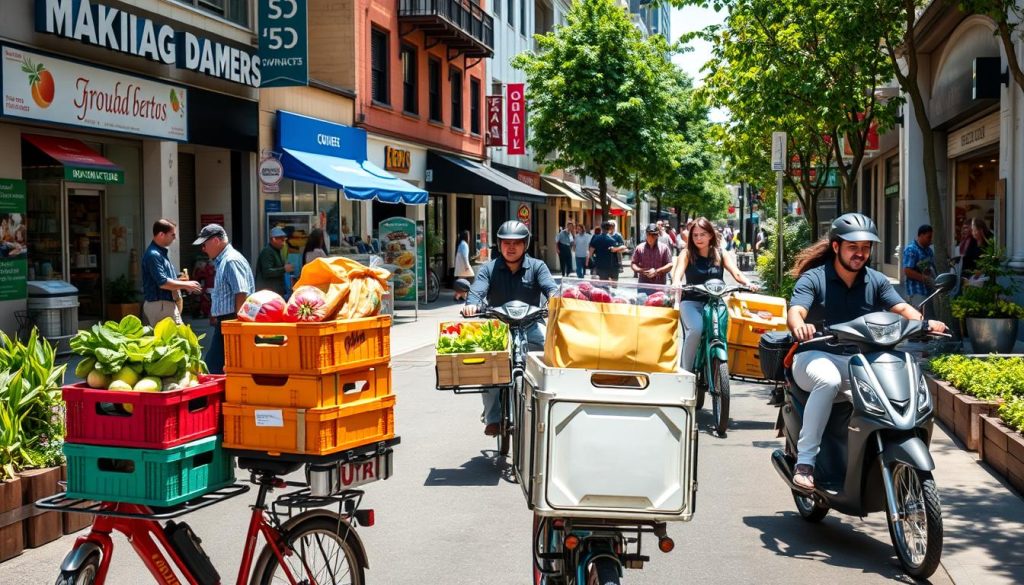In recent years, the fast local grocery delivery sector has grown a lot in the United Kingdom. It has changed how people shop for groceries online. Big names like Tesco, Ocado, and Sainsbury’s have changed their services to fit what customers want now.
Customers want things fast and easy, so these companies have stepped up. The grocery delivery UK market has seen a big increase in growth. Now, there are many options, from same-day delivery to flexible times, to suit everyone’s needs.
The Rise of Fast Local Grocery Delivery
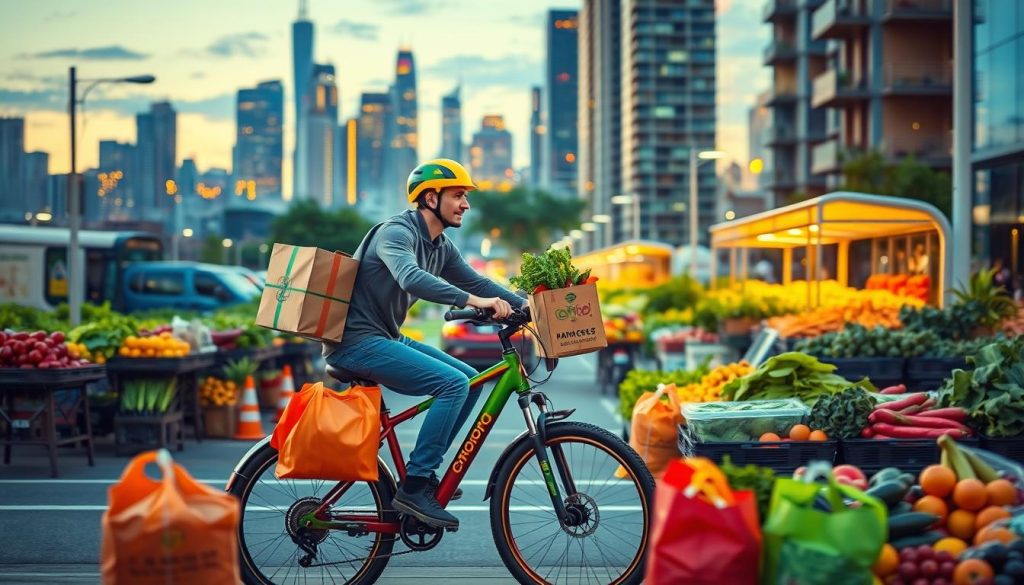
In recent years, how we shop has changed a lot. Thanks to new technology, more people are using grocery delivery services. Smartphones and online shopping have made it easy to get what we need without leaving home.
This change grew even more during the COVID-19 pandemic. Many chose delivery over going to the shops to stay safe. Now, it’s clear that convenience shopping is here to stay.
Changing Consumer Habits
Reports show a big jump in online grocery sales. This shows how shopping habits are changing. People want shopping to be easy and quick.
Now, many families use delivery services for their groceries. This shows how convenience shopping is part of our daily lives.
Understanding the Local Grocery Delivery Model
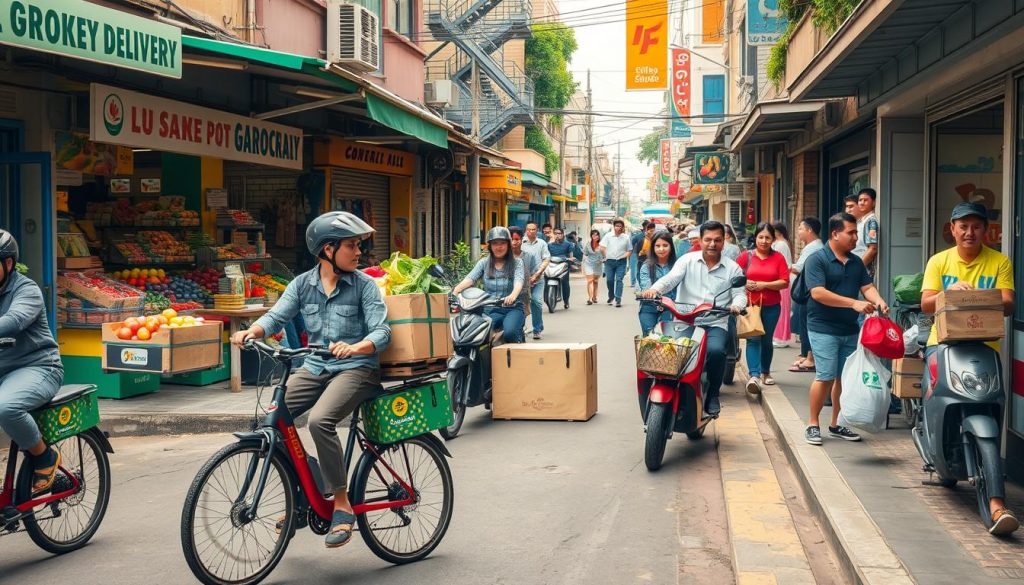
The local grocery delivery model changes how we get our daily essentials. It starts by picking products from nearby supermarkets. This keeps the stock fresh and cuts down delivery times. The model uses smart logistics and tech to make things run smoothly.
The last-mile delivery is key to this process. It’s the last step in getting products to customers. Good management here makes customers happy and keeps the service reliable. Companies use their own drivers or hire couriers to make sure deliveries are on time.
Being efficient is top priority. By using the latest tracking and delivery software, grocery services can keep an eye on orders in real-time. This helps them speed up deliveries and make sure orders are right.
Benefits of Local Grocery Delivery Services
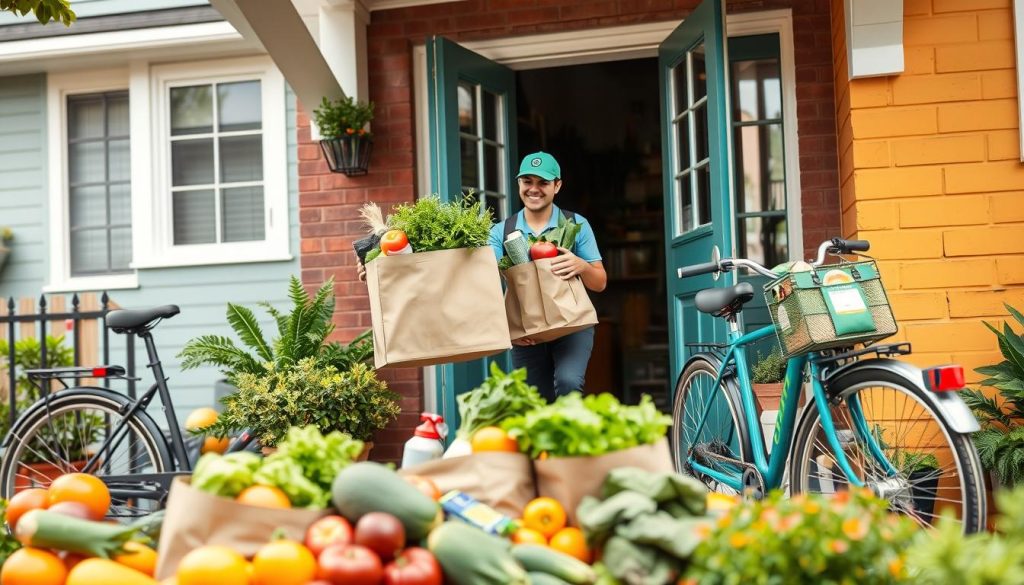
Local delivery services bring many benefits to grocery shopping. They save time by delivering groceries right to your door. This means no more walking through crowded aisles or waiting in long lines.
They also offer fresh produce and essentials. These services work with local farms and suppliers for top-quality products. This means you get the best items and support local businesses.
Using these services helps the local economy too. By choosing local delivery, you help small businesses grow. This keeps the community strong and supports unique local shops.
Local grocery delivery services offer more than just convenience. They benefit both customers and local shops, creating a positive cycle.
Local Grocery Delivery: How It Works

Local grocery delivery is easy and efficient. Customers pick their items using apps or websites from different services. It’s key for new users to know how it works for a smooth shopping experience.
After choosing items, the order process starts. This includes checking the list, picking delivery times, and paying. The service confirms the order and gives delivery times, making sure all items are ready or if substitutes are needed.
Getting groceries delivered on time is crucial. Items are checked carefully before being loaded into cars. Delivery people follow the best routes to get to customers fast. Keeping the groceries safe and fresh is also key.
This makes sure customers are happy with their delivery.
Key Players in the Local Grocery Delivery Market

The local grocery delivery market has grown a lot, showing many companies that meet different needs. Deliveroo and Uber Eats are leading the way by adding grocery delivery to their food services. They aim to make shopping easier for customers.
Tesco and Sainsbury’s are also big names with strong online and in-store presence. They’ve improved their websites to make ordering groceries simpler. Each company has its own way of competing in the grocery delivery market.
- Deliveroo: Known for fast delivery, it works with many local shops, making it a strong competitor.
- Uber Eats: Using its existing delivery network, Uber Eats offers grocery delivery too.
- Tesco: With a wide range of products and an easy-to-use app, Tesco is a top choice for convenience.
- Sainsbury’s: Focusing on quality and being eco-friendly, Sainsbury’s sells groceries and food delivery services.
These companies show how competitive the grocery delivery market is. They keep finding new ways to keep and gain customers. Keeping an eye on these companies will help us understand what shoppers want.
Essential Technology for Fast Grocery Delivery

The world of local grocery delivery is changing fast, thanks to new tech. Important tools and systems are key to making things run smoothly and keep customers happy. Apps for grocery delivery make it easy for people to look at products, order, and track their orders in real time.
Delivery management software is also vital. It helps plan the best routes and schedules for deliveries. This means orders arrive on time. By using data, this software makes things run better and cuts down on costs. This helps both companies and customers.
Now, the Internet of Things (IoT) is becoming more popular in this area. Smart devices keep an eye on stock levels, so there are no shortages. They make sure customers can get the items they want. AI algorithms look at what people buy to offer customised advice and make shopping more engaging.
In short, technology is crucial for the future of grocery delivery. By using modern apps, strong delivery software, and the latest IoT and AI, businesses can offer a smooth and efficient shopping experience. This makes shopping easier and more enjoyable for everyone.
Customer Experience in Local Grocery Delivery
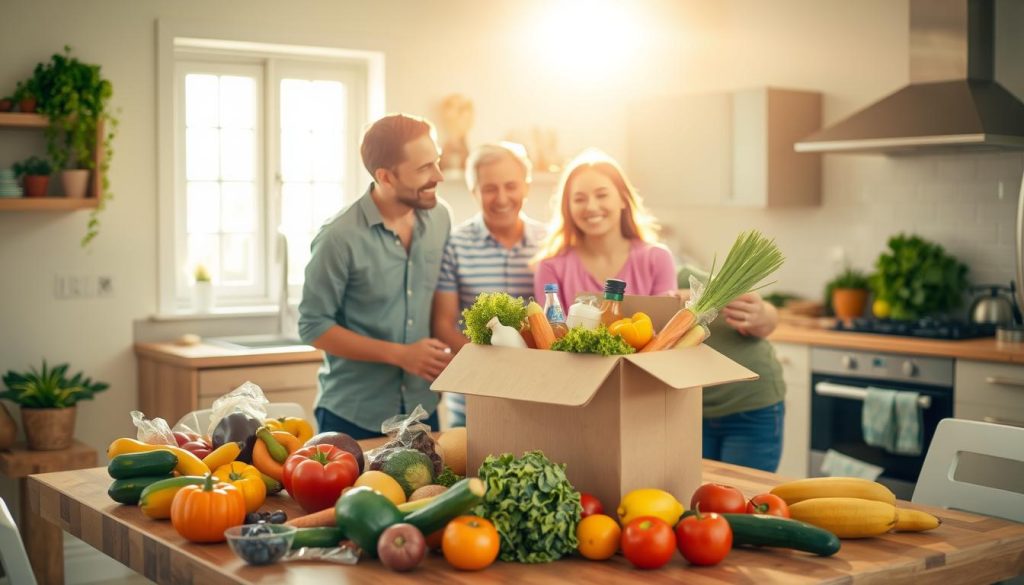
The customer experience is key to the success of local grocery delivery services. Things like how fast they deliver, the quality of products, and how well they help customers matter a lot. A smooth grocery delivery experience often goes beyond what customers expect. This makes them loyal and more likely to come back.
Listening to what users say is crucial for companies wanting to get better. By focusing on reviews, businesses can see what they’re doing right and what they need to work on. This helps them make things better and make sure customers are happy.
- Delivery Speed: Timely deliveries are crucial in the grocery sector.
- Product Quality: Consumers expect fresh and high-quality items.
- Customer Service: Prompt and professional support can significantly enhance customer satisfaction.
A positive customer experience has a big long-term effect. Happy customers often tell others about their good experiences. This can bring in new customers and help the business grow. As more companies compete, focusing on the grocery delivery experience will be even more important for success.
Local Grocery Delivery: Trends and Innovations
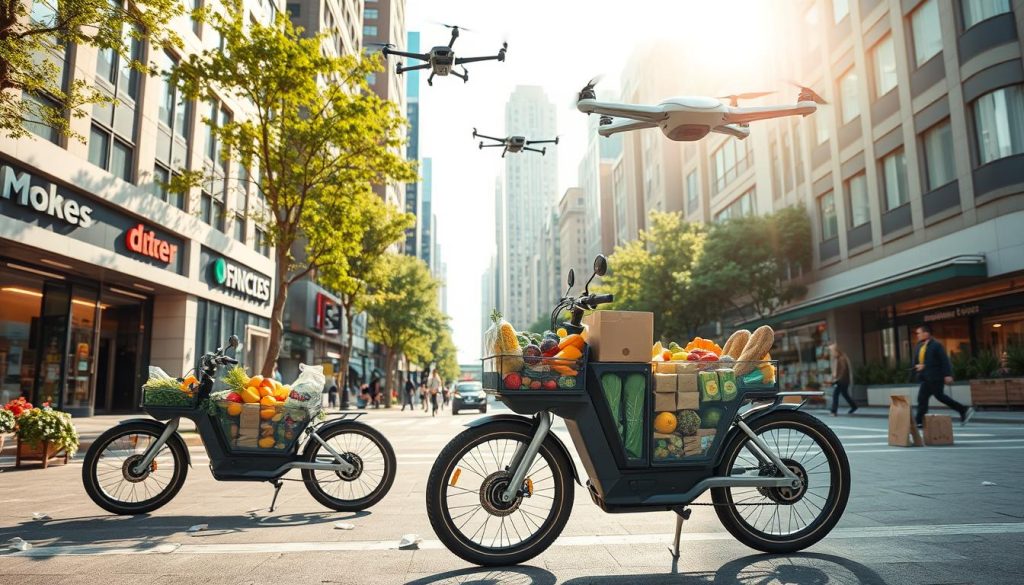
The world of grocery delivery is changing fast, thanks to new trends and services. Now, subscription services are becoming more popular. They send customers their favourite groceries regularly, making shopping easier and keeping customers coming back.
Technology is also changing how we shop for groceries. Drones are now delivering items quickly and safely. This is great for people who are always on the go. Contactless delivery is another big change, making shopping safer and more convenient.
Companies are using data to understand what customers like and how they shop. This helps them deliver groceries on time and meet customer needs. It shows how grocery shopping will become more personal and quick in the future.
Challenges Faced by Local Grocery Delivery Businesses
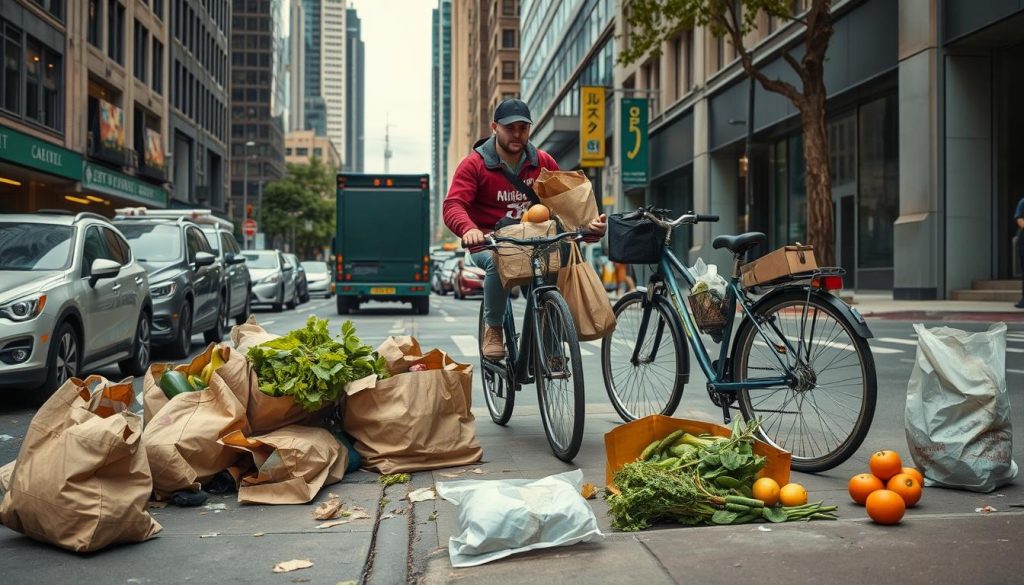
Local grocery delivery businesses face many challenges that affect their success. Ensuring timely and efficient deliveries is a big challenge. Managing routes can lead to problems that upset both customers and service providers.
High delivery costs are another big issue. Expenses for transport and labour can eat into profits. Businesses need to find new ways to cut costs while keeping prices low to draw in customers.
There’s a lot of competition in the market too. With many grocery apps out there, it’s hard for businesses to stand out. This competition makes it tough to keep prices low without hurting profits.
Consumer demand changes a lot, which is hard for businesses to keep up with. Seasonal changes and shifts in what people buy can lead to too much stock or not enough. Keeping product quality up during these times is crucial but hard.
Changes in laws can also affect grocery delivery businesses a lot. They need to stay on top of new rules, which can add more work. These challenges need creative solutions and careful planning to beat.
Sustainable Practices in Grocery Delivery
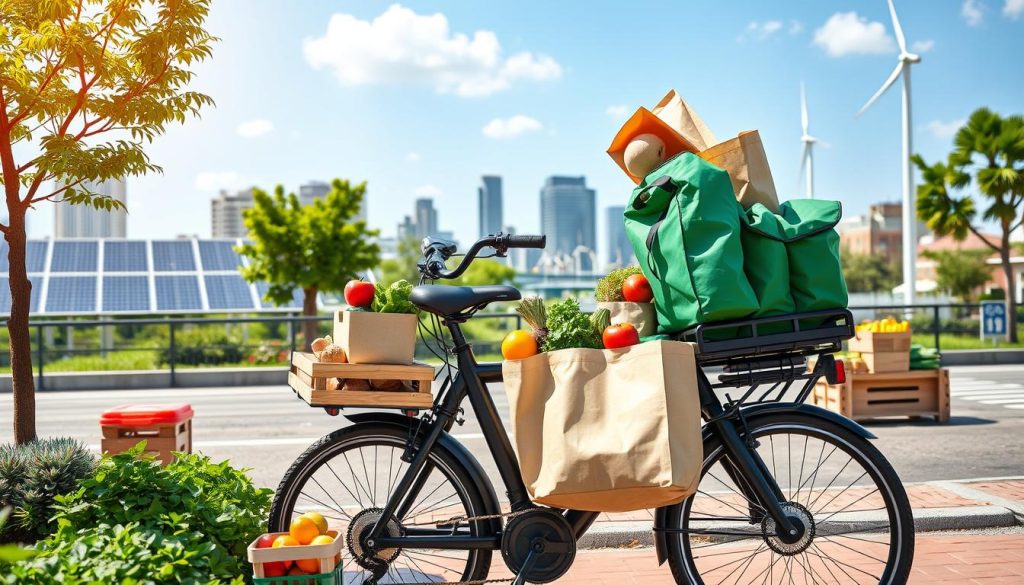
The grocery delivery industry is now focusing more on sustainable methods. It’s vital to fight climate change and cut down on carbon emissions. Many new initiatives aim to make delivery better for both customers and the planet.
Using electric delivery vehicles is a big step forward. These vehicles emit much less greenhouse gas than traditional cars. As electric tech gets better, more companies are adding these to their fleets. This makes the delivery process more efficient and green.
Improving delivery routes is also key to being more sustainable. By using smart routing software, companies can travel less and save time. This not only saves money but also cuts down on fuel use. It’s a big win for the environment.
Buying products from local suppliers is another important part of being sustainable. It means less travel for the goods and helps local businesses. This fits well with what more people want: fresh, local food.
How we package things is also crucial for being eco-friendly. Companies are now using materials that break down easily or can be recycled. This helps reduce waste and encourages customers to think about the planet when they shop.
Building a Reliable Local Grocery Delivery Network
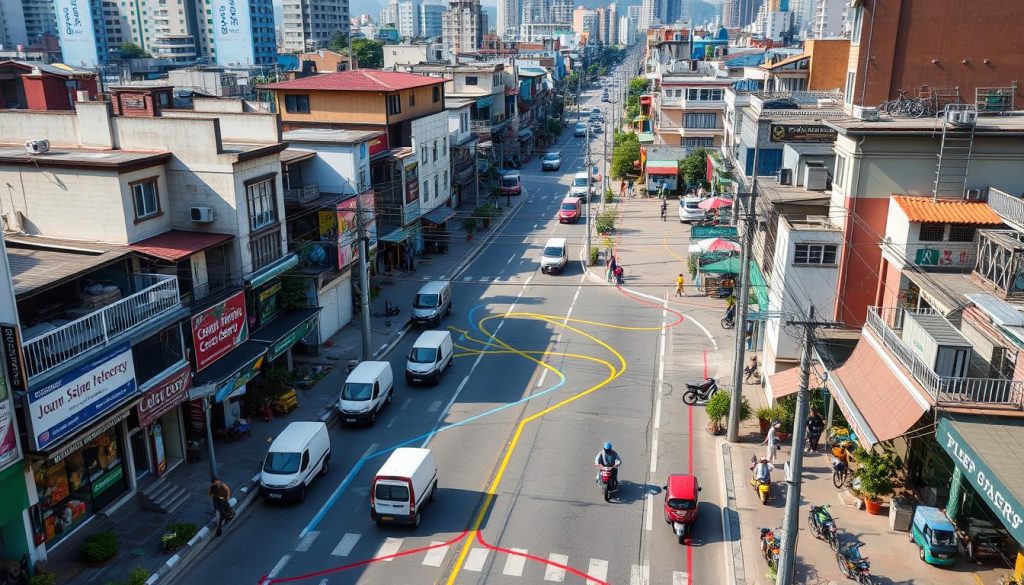
Creating a reliable delivery network is key for a local grocery service. It builds trust and satisfaction with customers. It’s not just about moving goods fast; it’s about strong logistics partnerships with suppliers and others. Working with trusted suppliers means better quality and more products, making the service more reliable.
Good communication is vital for a smooth delivery network. Deliverers need the right tech to talk with suppliers and keep customers happy. This helps avoid any mix-ups that could slow things down.
Having a plan B is also important. Knowing what might go wrong and being ready for it helps manage risks. Companies should think about things like traffic, the weather, and unexpected problems to keep deliveries on time.
Looking at successful networks shows how to make grocery delivery reliable. For example, using real-time tracking and listening to customers improves service. Training delivery staff in customer service also helps build better relationships and gets more repeat business.
- Identify and partner with reliable suppliers.
- Implement efficient communication tools for delivery personnel.
- Create contingency plans to address potential disruptions.
- Utilise technology to track deliveries and gather customer feedback.
- Train staff to improve customer service interactions.
Marketing Strategies for Grocery Delivery Startups
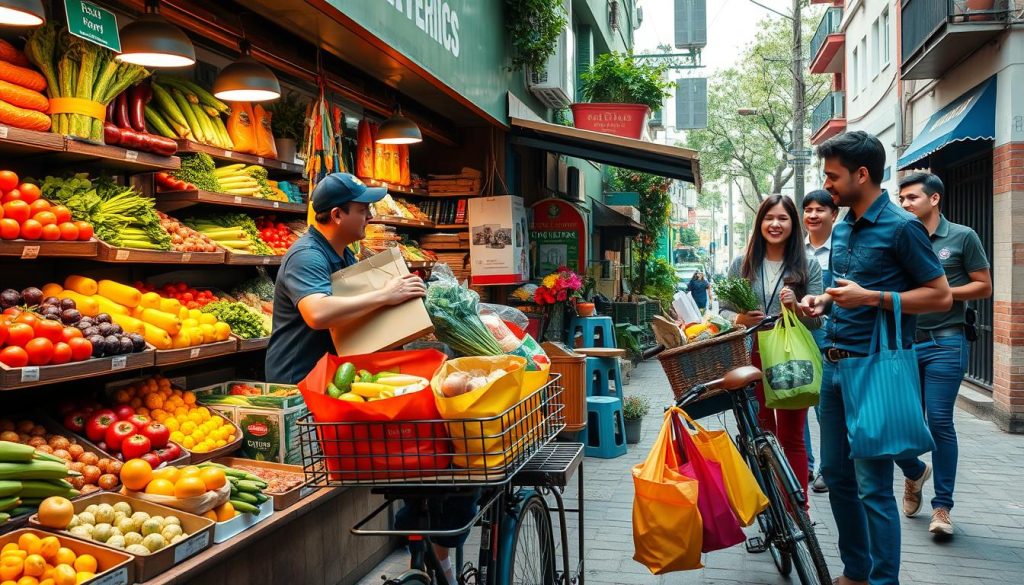
Marketing grocery delivery needs new ways to grab potential customers’ attention. Startups can use different ads to stand out in a busy market. Here are some top methods to think about:
- Online Marketing: Use search engine optimisation (SEO) to be more visible. Make content that draws people in and make your website easy to find for local searches.
- Social Media Campaigns: Instagram and Facebook are great for promoting your brand. Use eye-catching pictures and ads that target the right people to get more customers and increase traffic.
- Collaboration with Local Businesses: Working with popular local shops can make you more trusted. Together, you can run special deals that bring in new customers, helping everyone involved.
- Promotional Deals: Give discounts or special offers to first-time users to get them to try your service. Loyalty schemes keep customers coming back, building strong relationships over time.
- Brand Awareness Campaigns: In a busy market, having a strong brand identity is key. Keep your message clear and use high-quality images to make you stand out from others.
Using these strategies helps bring in new customers and strengthens your brand in the local grocery scene. This sets the stage for steady growth.
Future of Fast Local Grocery Delivery Services
The grocery delivery scene is set for big changes, with new trends and tech leading the way. We’re seeing fast growth in delivery services, driven by what customers want: quick and easy shopping. With the help of artificial intelligence and machine learning, handling orders will get smarter and more efficient.
Automation, especially with robotics, is set to make things run smoother. This means better efficiency and helping local grocery delivery grow. By using these new tools, shops will make shopping easier and faster for everyone.
Now, being green is key for the future of delivery services. Customers want to support brands that care for the planet. By focusing on eco-friendly practices and using the latest tech, local grocery shops can meet these needs. This approach will help them stay ahead in a competitive market.

